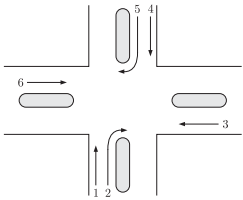Transportation Engineering - Online Test
Q1. For two major-roads with divided carriage way crossing at right angle, a full
clover leaf interchange with four indirect ramps is provided. Following statements
are made on turning movement of vehicles to all direction from both roads.
Identity the correct statement
Answer : Option B
Explaination / Solution:
No Explaination.
Q2. As per IRC : 67 : 2001, a traffic sign indicating the Speed Limit on a road should
be of
Answer : Option A
Explaination / Solution:
No Explaination.
Q3. Consider the following statements in the context of geometric design of roads.
I : A simple parabolic curve is an acceptable shape for summit curves
II : Comfort to passengers is an important consideration in the design of
summit curves.
The correct otption evaluating the above statements and their relationship is
Answer : Option A
Explaination / Solution:
No Explaination.
Q4. The design speed for a two-lane road is 80 km/h . When a design vehicle with a
wheelbase of 6.6 m is negotiating a borizontal curve on that road, the off-tracking
is measured as 0.096 m. The required widening of carriageway of the two-lane
road on the curve is approximately
Answer : Option C
Explaination / Solution:
No Explaination.
Q5. Consider the following statements in the context of cement concrete pavements
I : Warping stresses in cement concrete pavements are saused by the seasonal
variation in temperature.
II : Tie bars are generally provided across transverse joints of cement concrete
pavements.
The correct option evaluating the above statements is
Answer : Option D
Explaination / Solution:
No Explaination.
Q6. A crest vertical curve joins two gradients of + 3% and - %2 for a design speed of
80 km/h and the corresponding stopping sight distance of 120 m. The height of
driver’s eye and the object above the road surface are 1.20 m 0.15 m respectively.
The curve length (which is less than stopping sight distance) to be provided is
Answer : Option B
Explaination / Solution:
No Explaination.
Q7. On a specific highway, the speed-density relationship follows the Greenbegs
model [V = vf loge (kjk)], where vf and kj are the free flew speed and jam density
respectively. When the highway is operating at capacity, the density obtained as
per this model is
Answer : Option D
Explaination / Solution:
No Explaination.
Q8. A three-phase traffic signal at an intersection is designed for flows shown in the
figure below. There are six groups of flows identified by the numbers 1 through 6.
Among these 1, 3, 4 and 6 are through flows and 2 and 5 are right turning. Which
phasing scheme is not feasible ?




Answer : Option C
Explaination / Solution:
No Explaination.
Q9. An automobile with projected area 2.6 m2 is running on a road with a speed of
120 km per hour. The mass density and the kinematic viscosity of air are 1.2
kg/m3 and 1.5 × 10-5 m2/s, respectively. The drag coefficient is 0.30.
The drag force on the automobile is
Answer : Option D
Explaination / Solution:
No Explaination.
Q10. An automobile with projected area 2.6 m2 is running on a road with a speed of 120 km per hour. The mass density and the kinematic viscosity of air are 1.2 kg/m3 and 1.5 × 10-5 m2/s, respectively. The drag coefficient is 0.30.
The metric horse power required to overcome the drag force is
Answer : Option C
Explaination / Solution:
No Explaination.
